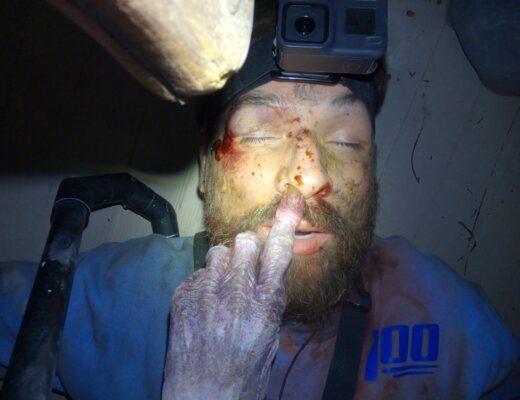In her remarkable 2021 book on James Benning’s Ten Skies, critic and scholar Erika Balsom remarks that the film “at once rewards a close attention to detail and sanctions wayward drift.” It’s a lovely turn of phrase, and one quite applicable to Sharon Lockhart’s new short film Eventide. The two artists — Benning and Lockhart — have cited each other’s works as influences in their own, and even published a book together last year, titled Over Time. Fittingly, both artists’ works are deceptively simple to describe, while simultaneously invoking larger formal and philosophical ideas about duration, stasis, and movement. As Chus Martinez writes, “her [Lockhart’s] images determine our understanding of time and action through the grieving discrepancy between aesthetic expectation and the seeming unity of time passing… a potentially endless stasis difficult to recognise or delimit in terms of action or conclusion.”
The simplest thing to do with Lockhart’s films is, of course, to look at them. Eventide begins with a single, static camera setup. It does not cut or move for the next 30 minutes. The horizon line cuts evenly across the frame; a body of water (this writer is not sure if it is an ocean or a lake) with small, gently lapping waves is on screen left, while a rocky shoreline and scattered shrubbery extend across the frame to the right. A particularly large bit of foliage sits in the middle of the image. It’s dark, although it’s at first unclear whether it is dawn or dusk. A man enters frame left, walking across the ground with a flashlight. Eventually, another body, a woman, emerges from the same direction just as the first person walks behind some of the shrubs and disappears from the frame. The second figure is further back in the depth of field, momentarily alone until the man re-emerges from behind the shrubs; he’s now on the same focal plane as the woman. While these figures slowly traverse the grounds, their flashlights pointed down in search of an unknown something or other, the sky darkens, and stars become more visible.
At around the eight-minute mark, a third figure appears, hitherto fully hidden by the shrubs and their distance from the camera (a game of focal lengths). A tiny pinprick of light appears in the deep background, suggesting now a fourth body. One of the people moves closer to the water, and the brightness of their flashlight begins reflecting off of the surface of the water, a lovely tinkling, shimmering light. Two more figures arrive; it’s unclear at first if one of them was the light source in the distance and has simply walked closer to the main point of action, but eventually that’s revealed, too. Six people are now wandering the ground, each of them illuminated by their flashlights. Even more stars are visible in the sky, as the increasing darkness of the evening throws the light sources into even sharper relief. Some of the people seem to pair off, assisting each other in their unknown quest, while others remain alone, content to investigate their own little patch of earth. What are they looking for? We don’t know, and no narrative information is forthcoming.
It’s a formal game, while also being, of course, a documentary of sorts, and the mixture of the two modes is where much of the interest lies. As in her films Double Tide and Goshogaoka, Eventide is a carefully choreographed performance piece (one could argue that it’s actually a direct synthesis of these two prior works) that gestures toward chance operations even as it’s, in actuality, a document of predetermined movements. The surface simplicity — a group of people wander about as dusk becomes dark — belies the precision of Lockhart’s decision-making. But the emphasis on time, that inalienable filmic element so frequently diminished and quashed by narrative allows for all manner of Balsom’s “wayward drift.” One is free to pay more or less attention to any part of the image at any given moment, so much so that viewers might not notice how bright the stars have become or that one or more of the figures have momentarily been obscured by the brush. In some sense, it even becomes Tati-like, inasmuch as Noël Burch recognized that the deep focus photography of Playtime allowed viewers to focus on only one part of the image at any given moment. For all its static austerity, then, Eventide is ultimately an entirely invigorating experience.
Published as part of InRO Weekly — Volume 1, Issue 13.







